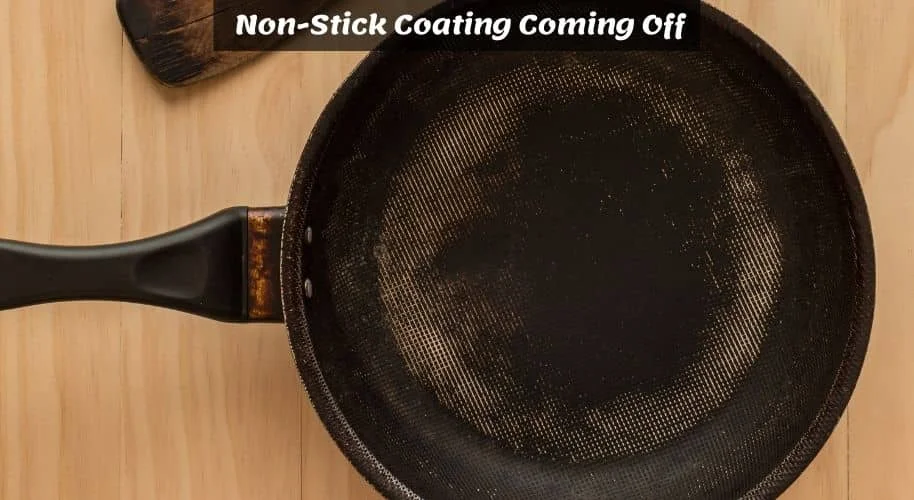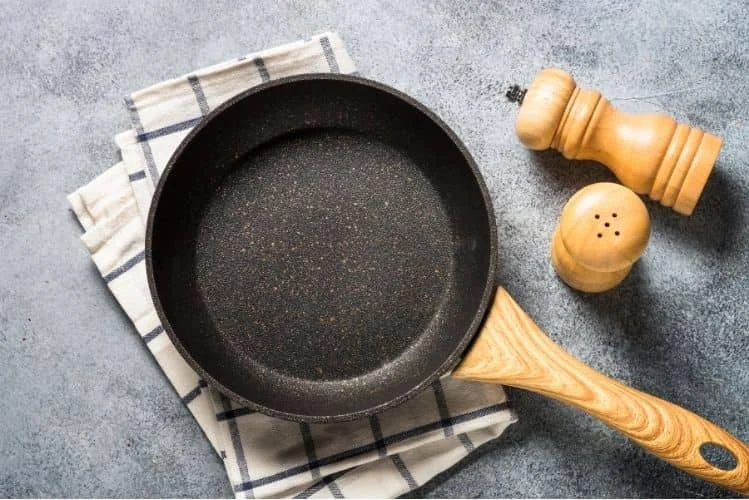Every kitchen has a number of useful utensils and appliances that can save the day in the event of a cooking incident. Non-stick kitchenware is an example of this. Nonstick pans are ideal for making breakfast pancakes and pan-seared meat since they are simple to use, convenient, and easy to maintain. It helps keep all of the flavors and aromas of your cuisine thanks to its amazing non-stick technology.
There is, however, a twist. A coating is generally applied on non-stick kitchenware. And it’s possible that the coating will come off at some point. In this post, we’ll look at what to do when the non stick coating coming off and, of course, the causes for it. But first, let’s discuss how to check if a pan is non-stick or not.

How Can You Tell If A Pan Is Non-Stick?
The signs may appear slight at first, but as you grow more aware of the differences, they will become more obvious. The non-stick pan will have a dark gray coating on the inside and a shiny metal exterior. As a result, the appearance of a non-stick pan will immediately distinguish it from others. Furthermore, when you initially purchase the pan, the cooking surface will be extremely smooth, shiny, and scratch-free.
The surface will never be dull or dry, unlike other pans. When you touch a non-stick pan, you will immediately perceive the difference. Other pans will feel grainier and uneven in comparison. Non-stick pans are also often lighter than cast iron pans. This is because they are constructed of aluminum and are Teflon-coated.
This is why non-stick pans have a distinct weight differential from ordinary pans. Another way to tell if a pan is non-stick is to look at it. Of course, if you need to know this before buying a non-stick pan, you may conduct a quick search (if buying online) or ask the salesperson in the store.
How Do Non-Stick Pans Work?
A non-stick pan’s metal surface is coated with polytetrafluoroethylene (PTFE), often known as Teflon. When a nonstick pan is heated, Teflon is the substance that coats the metal surface. The Teflon coating works as a barrier, preventing sticky hot food from coming into contact with the metal surface. As a result, the surface remains smooth and free of food.
What Causes Non-Stick Coating To Come Off?
The non-stick coating, as the standout feature of your cooking equipment, runs the danger of deteriorating over time. If you start noticing your pan’s non stick coating coming off, you might be making some of these blunders. Here are a few instances:
Not Seasoning Your Pan
If you don’t pre-season your pan before using it for the first time, the coating will be very susceptible to wear and tear. The coating will deteriorate over time, and failing to re-season your pan on a regular basis will exacerbate the problem.
Cooking With High Temperature
Heat is the number one factor that can degrade your non-stick pan’s protective coating. Besides, when a pan is heated above 500°F, the coating might become poisonous and begin to degrade. The non-stick coating can then transform into a possible carcinogen, in addition to being dangerous for cooking.
If you use the pan for high-heat cooking on a regular basis, the surface may deteriorate with time, and harmful vapors will be released, making your meal unpleasant. The majority of individuals smoke their nonstick pans, which can emit harmful compounds as well as damage the coating.
Using An Excessive Amount Of Non-stick Spray
One of the most typical cooking blunders is using non-stick spray. The goal of a non-stick spray is to coat the surface with a protective coating that prevents food from sticking. When the pan is designed to be non-stick, however, this is no longer necessary.
The buildup of non-stick spray on the surface will eventually adhere to the surface and fail to burn off while cooking. Even if you wash and rinse vigorously, the sticky coating is unlikely to come off. You may only need a strong bleach or a lot of elbow grease to remove it off the pan’s sides, which is a tremendous nuisance in and of itself.
Using A Dishwasher To Clean The Pan
This may be the most common mistake made by most people. Even though nonstick pans are dishwasher safe, they are still subjected to extremely hot water, vigorous scrubbing, and harsh cleaning agents. The damage may go unnoticed at first, but the nonstick pan’s covering will wear away over time.
Utilizing Abrasive Or Sharp Utensils
Because the coating is already sensitive, scarring the surface with sharp steel kitchen utensils while sautéing or tossing your food is a bad idea. Moreover, scratching the coating with metal spatulas, or forks might cause the food to adhere to the pan.
When cleaning the pan, this is particularly true. Most individuals make the mistake of utilizing steel wool, which causes pitting and peeling in the pan coating.
How To Fix a Non Stick Coating Coming Off?
Luckily, not everything is lost straight away. You can take steps to minimize the chance of pan coatings peeling and, in certain cases, even prevent it. Even if the damage has already occurred, there are certain things you might be able to do.
Remember that there may come a time when you’ll have no choice but to throw the pan because there’s nothing else you can do. Just because you have a small scratch or notice a change in the coating doesn’t mean it’s a bad thing. There are a few options and recommended practices to consider.
First and foremost, avoid the things listed above that could cause your non-stick coating to flake off. Here’s a quick rundown for you:
- Avoid scratching the surface with a metal or abrasive tools;
- Don’t use high heat for long periods of time or too frequently;
- Season your skillet on a regular basis;
- Don’t use a dishwasher;
- Don’t apply non-stick spray;
- Don’t cook acidic foods on your pan often.
Here are some other important options to consider:
Use A Non-Stick Cookware Repair Spray To Fix It
The first thing you should do is use a non-stick repair spray. A repair spray will readily save your pan if the damage isn’t too bad. Begin by washing the pan completely and gently scraping away all of the food bits and fat. Dry it thoroughly before applying a thick, even coat of non-stick repair spray.
You can get one from any convenience store — these are really ubiquitous. After spraying, set aside for 20-30 minutes before turning on the oven. The heat from heating the skillet will remove the sticky layer and allow the repair spray to work its magic.
Allow 45-50 minutes for the pan to cool completely before removing it. To avoid extreme temperature swings, keep it in the oven as it cools down. After that, rinse the pan with a soft sponge and light dish soap until all of the grease and debris has been removed. Now you can use your pan!
Getting Your Non-Stick Pans Seasoned
This is a precautionary measure that many people overlook when purchasing a non-stick pan.
However, it is possible that it will save your pan and allow it to endure much longer for you. If you season your pan on a regular basis, you’ll have fewer stains, scratches, and non-stick coating peeling.
You can’t just season it once. To be truly effective, you’ll need to practice this on a regular basis. Even if you just season your pan a few times a year, this procedure will go a long way toward preventing the non-stick coating from peeling away.
If your coating is already showing symptoms of wear, this may not be of much use. It’s a more proactive strategy. Don’t think you’re done once you’ve seasoned it. Season it and then re-season it as per a set schedule. Seasoning is easy to accomplish and doesn’t require a lot of money or effort. It will be well worth it, we assure you.
Also read:
How To Keep Your Non-Stick Pan Last Longer?

Taking care of your cooking tools, especially something as delicate as non-stick cookware, may keep it in great shape and run for a long time. Let’s face it, you can’t live without a non-stick pan, and given how expensive they are, it’s important to use them with prudence. Here are some simple safety recommendations to help you get the most out of your non-stick pan.
1. Select The Appropriate Stirring Tools
Stick to mild, non-abrasive stirring implements instead than all-metal spoons and spatulas. A wooden ladle can be used to stir and toss sticky foods like chicken, vegetables, and fish. Wood is a softer material than metal and does not scratch. However, if you’re making something complicated, such as a pancake, you might want to think about other options.
Silicone utensils are unquestionably the best. They’re soft, bendable, and dishwasher safe. Silicone spatulas are ideal for cooking light dishes like eggs, veggie stir fry, or fritters since they readily flip the food without damaging the pan. Consider nylon utensils, which are more durable than silicon, for heavier items like sirloin, fish fillets, and tortillas. However, no matter what equipment you use, don’t be too hard on the pan.
2. Store Them Correctly
Just as you must be cautious while washing nonstick cookware, you must also be cautious when storing it. It’s not a good idea to just put it in a cabinet because the impact could harm it. Put it away in a large cupboard where it won’t get in the way of other kitchen tools.
3. Avoid High Heat
Your nonstick pan isn’t designed to handle high-heat or acidic foods. For this, you can utilize a cast-iron skillet or a grill pan. Soft scrambles, pancakes, tortillas, frittatas, and lean meats are excellent for cooking in a nonstick pan.
They cook swiftly and don’t adhere to the pan’s surface. It’s also best to use stainless steel for color-changing recipes that need caramelizing onions or butter. This will protect it from scratches and keep it safe.
4. Adding Fat At The Appropriate Moment
Rather than waiting for the pan to heat up before adding the butter or oil, do it immediately after lighting the flame. This is required for nonstick cookware because it prevents the layer from overheating and extends the life of the product. If you add fat after it has been heated, you risk igniting harmful fumes, which can make your dish exceedingly unhealthy.
5. Clean It Gently
Scrape off only the top layer of oil and food from the pan. To preserve the pan from erosion, a thin layer of oily coating should always remain on it. Use light dish soap and a soft sponge to clean the cookware once or twice a day, depending on how often you use it. Before putting it away in a cabinet, make sure it’s completely dry. With these nonstick cookware safety precautions, you’ll never have to worry about a scratch or stain on your pan again!
However, if you still notice the non stick coating is coming off, you can remove non stick coating from pan. It will make sure the non stick flakes will not get mixed with the food when cooking.
When Should You Consider Throwing Away a Non-Stick Pan?
Regardless of how hard you try, you’ll eventually have to throw that pan and replace it. If you’ve been putting off looking for a solution, now is the moment. If the coating is flaking or peeling, the pan should be replaced.
While the coating may not make you sick, it is possible that you will eat harmful substances as a result of it flaking or peeling into your meal. Here are several indications that your nonstick pan needs to be replaced:
- The coating is peeling away;
- The pan has formed a warp;
- The pan has a lot of discoloration on it;
- The non-stick coating coming off;
- There are many scratches.
While there are certain things you can do to repair your non-stick pan and even come back from minor mishaps, it’s far preferable to be proactive and take steps to prevent your non-stick coating from peeling in the first place. You should replace the pan and cease using it once it starts flaking or peeling. Give yourself a new one.
Take Away
Thanks for reading the complete guide on why is your non stick coating coming off. We hope you’ve found this guide helpful and informative. To sum up, we just want to mention that if your non-stick coating starts to peel off, stop using the pan immediately and wash it with hot, soapy water. Do not put it in the dishwasher. You can try re-coating the pan with a non-stick cooking spray, but if this does not work, it is time to invest in a new set of cookware.
Have you experienced this issue with your cookware? Please share your story in the comments below.
Sharing is caring!
My name is Lori Walker. I’m a registered dietitian, food blogger and food enthusiast. I share easy healthy, delicious recipes on my blog and review necessary kitchen items. The recipes I share take less… Read more
